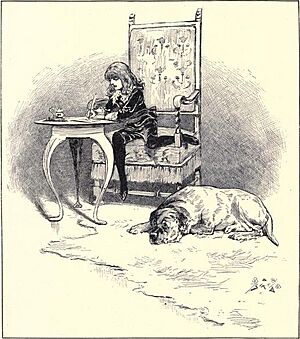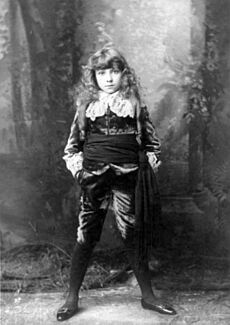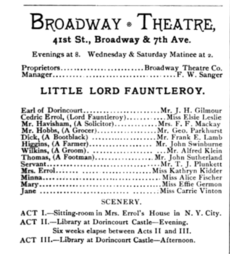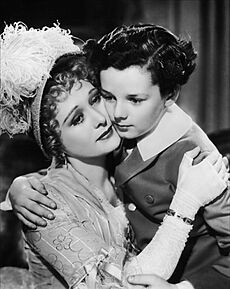Little Lord Fauntleroy facts for kids

First edition cover
|
|
| Author | Frances Hodgson Burnett |
|---|---|
| Illustrator | Reginald B. Birch |
| Country | United Kingdom United States |
| Language | English |
| Genre | Children's novel |
| Publisher | Scribner's |
|
Publication date
|
November 1885 – October 1886 (magazine) 1886 (novel) |
| Pages | xi + 209 + [17] |
| LC Class | PZ7.B934 L |
Little Lord Fauntleroy is a famous children's novel written by Frances Hodgson Burnett. It was first published in a magazine called St. Nicholas Magazine between November 1885 and October 1886. Later, it became a book in 1886. The beautiful drawings by Reginald B. Birch helped make the story popular and even influenced fashion! This book also made history in copyright law because Burnett won a case in 1888 to protect her story from being used in plays without her permission.
Contents
The Story of Cedric
A Boy from New York
In the 1880s, a kind young boy named Cedric Errol lives in New York City with his loving mother. They don't have much money after Cedric's father, Captain Cedric Errol, passed away. One day, a lawyer from England visits them. He brings a surprising message from Cedric's grandfather, the Earl of Dorincourt. The Earl is a very rich man who didn't like America and was upset when his son married an American woman.
A New Life in England
Now, because his father's older brothers have also passed away, Cedric is the next in line to become an Earl. He has inherited the special title of Lord Fauntleroy and will one day own a huge estate in England. His grandfather wants him to move to the United Kingdom and learn how to be a British aristocrat. The Earl offers Cedric's mother a house and money, but he still doesn't want to have anything to do with her. However, Cedric's mother politely refuses his money.
Cedric's Good Influence
The Earl is very impressed by Cedric's polite manners and smart questions. He is also charmed by Cedric's innocent and kind heart. Cedric believes his grandfather is a good and honorable man, and the Earl doesn't want to disappoint him. Because of Cedric, the Earl starts to become much kinder to the people who live on his land. He helps them, and everyone is very happy. The Earl makes sure they know that their new helper is actually young Lord Fauntleroy.
A Challenge to the Inheritance
Meanwhile, back in New York, Cedric's old friend, Mr. Hobbs the grocer, hears a strange story from a shoeshiner named Dick Tipton. Dick tells him about his brother Benjamin, whose wife left him and their child years ago. Around the same time, someone in England claims to be the true heir to the Earl's fortune, saying they are the child of the Earl's oldest son. Dick and Benjamin travel to England to investigate. They discover that the woman making the claim is actually Benjamin's former wife. She quickly leaves, and the Tipton brothers, along with Benjamin's son, do not see her again. Benjamin then returns to California to raise his son happily. The Earl realizes that Cedric's American mother is a wonderful person, much better than the woman who tried to trick them.
A Happy Ending
The Earl had planned to teach Cedric how to be a proper aristocrat. But instead, Cedric teaches his grandfather an important lesson: a true nobleman should be kind and caring towards everyone, especially those who depend on him. The Earl becomes the good man Cedric always believed him to be. Cedric is joyfully reunited with his mother and Mr. Hobbs, who decides to stay in England to help look after Cedric.
Fashion Trends from the Book
The Fauntleroy Suit

The book described Cedric's special outfit so well, and Reginald Birch's detailed drawings brought it to life. This led to a big fashion trend for boys in America! Many middle-class children started wearing what was called the "Fauntleroy suit."
The book describes it like this:
What the Earl saw was a graceful, childish figure in a black velvet suit, with a lace collar, and with lovelocks waving about the handsome, manly little face, whose eyes met his with a look of innocent good-fellowship.
—Little Lord Fauntleroy
A Popular Style
The Fauntleroy suit became popular in Europe too, but it was most famous in the United States. The classic suit included a velvet jacket that was cut short in the front, matching knee-length pants, a fancy shirt, and a large lace or ruffled collar. These suits became very fashionable right after the book was published in 1885 and stayed popular until the early 1900s.
Many boys didn't wear the full Fauntleroy suit but still wore parts of it, like a fancy shirt or a big floppy bow. Some boys even wore ringlet curls with these suits, as old photographs show. This style was most common for boys aged 3 to 8, but some older boys wore them too. It's thought that this popular style encouraged mothers to dress their boys in pants earlier than before, and it helped reduce the trend of dressing small boys in dresses or skirts. The clothes that Burnett made popular were actually based on outfits she designed for her own two sons, Vivian and Lionel.
Bringing the Story to Life: Adaptations
Stage Plays
The first play based on the novel, also called Little Lord Fauntleroy, opened in London on February 23, 1888. It was written by E.V. Seebohm. After finding out her story was used without permission, Frances Hodgson Burnett successfully sued. Then, she wrote her own play called The Real Little Lord Fauntleroy. This play opened in London on May 14, 1888, and was later performed in other parts of England, France, Boston, and New York City.
The Broadway version of Burnett's play opened in New York City on December 10, 1888. Famous actors played the roles, including Elsie Leslie as Cedric Errol. Touring versions of the play were very common in the late 1800s and early 1900s. In 1906, a famous comedian named Buster Keaton played Lord Fauntleroy when he was 11 years old!
Movies and TV Shows
Little Lord Fauntleroy has been made into many movies and TV shows over the years. Here are some of the most well-known adaptations:
- Little Lord Fauntleroy (1914): A British silent film.
- Little Lord Fauntleroy (1918): A Hungarian silent film.
- Little Lord Fauntleroy (1921): An American silent film starring Mary Pickford, who played both Cedric and his mother!
- L'ultimo Lord (1926): An Italian silent film.
- Little Lord Fauntleroy (1936): This is one of the most famous versions, starring Freddie Bartholomew as Cedric and C. Aubrey Smith as the Earl.
- Il ventesimo duca (1945): An Italian film.
- O Pequeno Lord (1957): A Brazilian soap opera.
- Little Lord Fauntleroy (1957): An American TV miniseries.
- Il piccolo Lord (1960): An Italian TV miniseries.
- Der kleine Lord (1962): A German TV film.
- Lille Lord Fauntleroy (1966): A Norwegian TV film.
- O Pequeno Lord (1967): A Brazilian remake of the 1957 version.
- Il Piccolo Lord (1971): An Italian TV movie.
- Little Lord Fauntleroy (1976): A BBC TV miniseries.
- As one installment in 1977 of the children's television show Once Upon a Classic.
- Little Lord Fauntleroy (1980): Another very popular movie, starring Ricky Schroder as Cedric and Alec Guinness as the Earl. This film is a Christmas favorite in Germany.
- The Adventures of Little Lord Fauntleroy (1982): A TV movie.
- Little Lord Fauntleroy (1988): A Japanese anime series, also known as Shōkōshi Cedie (Little Prince Cedie). It had 43 episodes and was translated into many languages.
- Il Piccolo Lord/Der kleine Lord (1994): An Italian and German co–production TV movie.
- Little Lord Fauntleroy (1995): A BBC TV mini-series.
- Cedie: Ang Munting Prinsipe (Cedie: The Little Prince) (1996): A film adaptation from the Philippines.
- Little lord's joy and sorrow (Russian: Радости и печали маленького лорда, romanized: Radosti i pechali malenʹkogo lorda) (2003): A Russian film.
- Little Lady (2012): An Austrian TV movie.
There have been many other films and TV series from different countries, showing how popular this story remains around the world!
See also
 In Spanish: El pequeño lord para niños
In Spanish: El pequeño lord para niños





